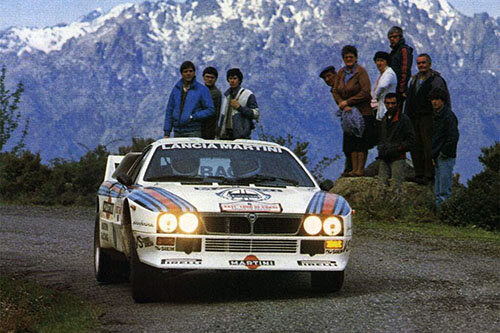Guide: Fine Tuning the Champion - a Historical & Technical Appraisal of the Lancia Delta HF Integrale
Background
Although Lancia convincingly won the 1987 World Rally Championship with their Delta HF Turbo 4WD, the car had been developed before the FIA announced their 1987 ban on Group B cars.
That bombshell came in May 1986, the same month the HF Turbo 4WD was launched; it was a fortuitous coincidence and gave Lancia an ideal platform for the new Group A era.
The first Delta designed from the outset to homologate a Group A competition variant was the HF Integrale launched at the Turin Motor Show in November 1987. Most significantly, it came with a host of engine, suspension and body modifications to keep Lancia ahead of the rapidly improving competition.
For 1988, stiff opposition was expected from Ford (Sierra Cosworth) and Toyota (Celica GT-Four).
Engine & Gearbox
Many of the upgrades introduced on the HF Integrale were focused on the engine. Among them was a larger capacity Garrett T3 turbo with improved air flow and a bigger intercooler. There were also new valves, valve seats and an improved water pump. The oil and water radiators were increased in size, a more powerful cooling fan was fitted and a more efficient air cleaner installed.
Another upgrade was a shorter 3.111:1 final drive ratio for the five-speed gearbox.
Compression remained unchanged at 8.0:1 but, with re-mapped Weber IAW engine management, the power output rose to 185bhp at 5000rpm (delivered at 250rpm less than the outgoing HF Turbo 4WD).
The torque rating was now 224lb-ft at 3500rpm compared to 210lb-ft at 2750rpm.
Displacement of the Aurelio Lampredi-designed inline four cylinder DOHC engine stayed at 1995cc.
Chassis
The steel bodyshell was equipped with coil sprung independent suspension via MacPherson struts at the front and double transverse arms at the rear. Hydraulic shocks were installed along with anti-roll bars at each end.
This latest version was further improved with uprated springs, dampers and front struts.
There were also larger 284mm ventilated disc brakes at the front, better pads at the back plus a larger brake master cylinder and servo.
The 15 x 5.5-inch eight-hole wheels used on the HF Turbo 4WD were widened to 6.5-inches. They came painted with graphite centres and were shod with Pirelli P700 tyres.
Bodywork
Wider wheels meant the fenders had to be flared and this in turn necessitated modifying the sills.
Other external changes to the original Giugiaro design included a bank of engine cooling vents carved out from the bonnet, matt black bumper inserts that wrapped around to the wheelarches, a subtly reworked front apron that offered improved cooling and body coloured wing mirrors.
There were also new HF Integrale badges front and rear.
Interior
Internally, nothing was changed and the Integrale used the same dash, instrumentation and switchgear as its predecessor.
The seats were trimmed in grey fabric with multi-coloured velour centres to match the door panels.
The black plastic dash featured an integrated binnacle directly behind the three-spoke steering wheel. It housed a large speedometer and rev counter, in between which were a series of warning lights and smaller read outs for turbo boost, battery amps, fuel and water temperature.
An additional pair of smaller gauges (for oil pressure and oil temperature) were housed at the top of the central control panel along with a schematic warning light display. The rest of the switchgear, along with the audio system, was located just below.
Electric windows were standard at the front but not at the rear.
Weight / Performance
Although it tipped the scales at 1267kg (which was 67kg more than its predecessor), the Integrale was a blistering performer.
Top speed officially remained at 133mph but the 0-62mph time dropped from 6.6 to 6.4 seconds.
Options
Optional upgrades included leather trim, Martini seats, Martini decals, a sunroof and a leather steering wheel.
Production
By the time production ended in mid 1989, 9841 Integrales had been completed, all of which were left-hand drive.
Competition History
Homologation was granted in time for the Integrale to make its Group A debut on the Portuguese Rally in March (round three of the 1988 World Championship). By this time, the HF 4WD had already won in Monte Carlo and Sweden.
As expected, the Integrale was a massive success. It won eight of the remaining eleven World Championship rounds that year and ensured Lancia retained their Manufacturer’s title. The Martini-backed outfit scored 140 points compared to Ford’s 79 and Audi’s 71.
For the second year in succession, Lancia crews finished first, second and third in the Driver’s Championship. Miki Biasion took the 1988 title with 115 points, second-placed Markku Alen scored 86 and Alex Fiorio finished on 76 points for the semi-works Jolly Club team.
1989 was the second season of competition for the Integrale. That year it won seven WRC events and most of those it didn’t win were rallies Lancia chose not to attend.
The last victory of 1989 (at Sanremo) came courtesy of a newly homologated 16-valve derivative that had been launched back in May 1989. Resplendent in a new red Martini livery, the works 16 valve car of Biasion finished ahead of Fiorio in an older 8-valve model.
By this time, Lancia had already done enough to clinch the Driver and Manufacturer titles. Sanremo therefore marked a victorious end to the season as the works cars did not travel to the Ivory Coast or Great Britain for the final two events of 1989.
Biasion (106 points) and Fiorio (65 points) placed first and second in the Driver’s standings.
With 140 points, Lancia finished comfortably ahead of Toyota (101) and Mazda (67) in the Manufacturer’s league.
Privateers continued to rally the 8-valve Integrale beyond 1989, often with success at national level. However, Lancia’s works and distributor teams all switched to the 16-valve model for 1990.
Text copyright: Supercar Nostalgia
Photo copyright: Lancia - https://www.lancia.com







































